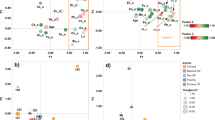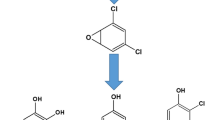Abstract
Aniline is an important starting material in the manufacture of polyurethane-based plastic materials. Aniline-derived methemoglobinemia (Met-Hb) is well described in exposed workers although information on the dose–response association is limited. We used an experimental design to study the association between aniline in air with the formation of Met-Hb in blood and the elimination of aniline in urine. A 6-h exposure of 2 ppm aniline in 19 non-smoking volunteers resulted in a time-dependent increase in Met-Hb in blood and aniline in urine. The maximum Met-Hb level in blood (mean 1.21 ± 0.29 %, range 0.80–2.07 %) and aniline excretion in urine (mean 168.0 ± 51.8 µg/L, range 79.5–418.3 µg/L) were observed at the end of exposure, with both parameters rapidly decreasing after the end of exposure. After 24 h, the mean level of Met-Hb (0.65 ± 0.18 %) returned to the basal level observed prior to the exposure (0.72 ± 0.19 %); whereas, slightly elevated levels of aniline were still present in urine (means 17.0 ± 17.1 vs. 5.7 ± 3.8 µg/L). No differences between males and females as well as between slow and fast acetylators were found. The results obtained after 6-h exposure were also comparable to those observed in four non-smoking volunteers after 8-h exposure. Maximum levels of Met-Hb and aniline in urine were 1.57 % and 305.6 µg/L, respectively. Overall, our results contribute to the risk assessment of aniline and as a result, the protection of workers from aniline-derived adverse health effects at the workplace.







Similar content being viewed by others
References
American Conference of Governmental Industrial Hygienists (ACGIH) (2013) TLVs® and BEIs®. Threshold limit values for chemical substances and physical agents and biological exposure indices, Cincinnati, OH, USA
Beutler E, Mitchell M (1968) Special modifications of the fluorescent screening method for glucose-6-phosphate dehydrogenase deficiency. Blood 32:816–818
Blaszkewicz M (2004) N-acetyltransferase 2 (phenotyping: caffeine test). In: Angerer J, Müller M (eds) Analyses of hazardous substances in biological materials. Special issue: marker of susceptibility, vol 9. Wiley-VCH, Weinheim, pp 165–182
BMAS, Federal Ministry of Labour and Social Affairs (2006) TRGS 900 occupational threshold limits, aniline 07/2013 [in German], Berlin, Germany. http://www.baua.de/de/Themen-von-A-Z/Gefahrstoffe/TRGS/TRGS.html
BMAS, Federal Ministry of Labour and Social Affairs (2013) TRGS 903 occupational threshold limits in biological materials (BGW), aniline 05/2013 [in German], Berlin, Germany. http://www.baua.de/de/Themen-von-A-Z/Gefahrstoffe/TRGS/TRGS.html
Bradberry SM (2003) Occupational methaemoglobinaemia. Mechanisms of production, features, diagnosis and management including the use of methylene blue. Toxicol Rev 22:13–27
Bright JE, Woodman AC, Marrs TC, Wood SG (1987) Sex differences in the production of methaemoglobinaemia by 4-aminopropiophenone. Xenobiotica 17:79–83
Coleman MD, Coleman NA (1996) Drug-induced methaemoglobinaemia. Treatment issues. Drug Saf 14:394–405
Department of Labor (DOL) (1994) Code of federal regulations CFRGBR 29, 1910.1000; Washington, DC 20402, USA
Dutkiewicz T, Piotrowski J (1961) Experimental investigations on the quantitative estimation of aniline absorption in man. Pure Appl Chem 3:319–323
El-Bayoumy K, Donahue JM, Hecht SS, Hoffmann D (1986) Identification and quantitative determination of aniline and toluidines in human urine. Cancer Res 46:6064–6067
European Chemicals Bureau (ECB) (2004) Aniline. European Union Risk Assessment Report, 1st Priority List, vol. 50, Office for Official Publications of the European Communities, Luxemburg
Foltz LM, Dalal BI, Wadsworth LD et al (2006) Recognition and management of methemoglobinemia and hemolysis in a G6PD-deficient patient on experimental anticancer drug Triapine. Am J Hematol 81:210–211
García-Closas M, Malats N, Silverman D et al (2005) NAT2 slow acetylation, GSTM1 null genotype, and risk of bladder cancer: results from the Spanish Bladder Cancer Study and meta-analyses. Lancet 366:649–659
Jenkins FP, Robinson JA, Gellatly JB, Salmond GW (1972) The no-effect dose of aniline in human subjects and a comparison of aniline toxicity in man and the rat. Food Cosmet Toxicol 10:671–679
Kim YC, Carlson GP (1986) The effect of an unusual work shift on chemical toxicity. II. Studies on the exposure of rats to aniline. Fund Appl Toxicol 7:144–152
Korinth G, Schaller KH, Bader M et al (2012) Comparison of experimentally determined and mathematically predicted percutaneous penetration rates of chemicals. Arch Toxicol 86:423–430
Kütting B, Göen T, Schwegler U et al (2009) Monoarylamines in the general population—a cross-sectional population-based study including 1004 Bavarian subjects. Int J Hyg Environ Health 212:298–309
Leng G, Bolt HM (2008) Substances generating methemoglobin [in German], In: Drexler H, Hartwig A (eds) The MAK Collection for Occupational Health and Safety, Wiley-VCH, Weinheim. http://onlinelibrary.wiley.com/doi/10.1002/3527600418.bb6253d0015/pdf
Lewalter J, Korallus U (1985) Blood protein conjugates and acetylation of aromatic amines. New findings on biological monitoring. Int Arch Occup Environ Health 56:179–196
Liao YP, Hung DZ, Yang DY (2002) Hemolytic anemia after methylene blue therapy for aniline-induced methemoglobinemia. Vet Hum Toxicol 44:19–21
Luceri F, Pieraccini G, Moneti G, Dolara P (1993) Primary aromatic amines from side-stream cigarette smoke are common contaminants of indoor air. Toxicol Ind Health 9:405–413
Monsé C, Sucker K, van Thriel C et al (2012) Considerations for the design and technical setup of a human whole-body exposure chamber. Inhal Toxicol 24:99–108
Moore LE, Baris DR, Figueroa JD et al (2011) GSTM1 null and NAT2 slow acetylation genotypes, smoking intensity and bladder cancer risk: results from the New England bladder cancer study and NAT2 meta-analysis. Carcinogenesis 32:182–189
Mullick P, Kumar A, Dayal M, Babbar S, Kumar A (2007) Aniline-induced methaemoglobinaemia in a glucose-6-phosphate dehydrogenase enzyme deficient patient. Anaesth Intensive Care 35:286–288
Patil SS, Shinde VM (1988) Biodegradation studies of aniline and nitrobenzene in aniline plant waste water by gas chromatography. Environ Sci Technol 22:1160–1165
Pauluhn J (2002) Aniline-induced methemoglobinemia in dogs: pitfalls of route-to-route extrapolations. Inhal Toxicol 14:959–973
Piotrowski J (1957) Quantitative estimation of aniline absorption through the skin in man. J Hyg Epidemiol Microbiol Immunol 1:23–32
Piotrowski J (1972) Certain problems of exposure tests for aromatic compounds. Pracov Lék 24:94–97
Scientific Committee on Occupational Exposure Limits (SCOEL) (2010) Recommendation from SCOEL for aniline, SCOEL/SUM/153
Smyth HF (1931) The toxicity of certain benzene derivatives and related compounds. J Ind Hyg 13:87–96
Weiss T, Angerer J (2002) Simultaneous determination of various aromatic amines and metabolites of aromatic nitro compounds in urine for low level exposure using gas chromatography–mass spectrometry. J Chromatogr B 778:179–192
Acknowledgments
This research was sponsored by a consortium consisting of BASF Polyurethanes GmbH (Lemförde, Germany), Bayer MaterialScience AG (Leverkusen, Germany) and LANXESS Germany GmbH (Leverkusen, Germany). The study designs, study parameters, evaluation, content and the opinions of this article are solely the responsibility of the authors and do not necessarily represent the official views of the consortium or individual members therein. The authors would like to thank all participating volunteers and technical staff at IPA and IfaDo and Dr. Rosemarie Marchan for editorial review prior submission.
Conflicts of interest
The authors declare that they have no conflict of interest.
Author information
Authors and Affiliations
Corresponding author
Additional information
Heiko Udo Käfferlein and Horst Christoph Broding have contributed equally to the work.
Rights and permissions
About this article
Cite this article
Käfferlein, H.U., Broding, H.C., Bünger, J. et al. Human exposure to airborne aniline and formation of methemoglobin: a contribution to occupational exposure limits. Arch Toxicol 88, 1419–1426 (2014). https://doi.org/10.1007/s00204-014-1266-y
Received:
Accepted:
Published:
Issue Date:
DOI: https://doi.org/10.1007/s00204-014-1266-y




